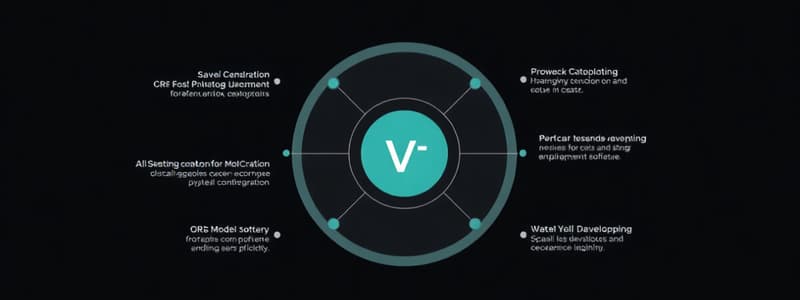Podcast
Questions and Answers
What does the V in V-Model stand for?
What does the V in V-Model stand for?
- Visual
- Version
- Validation (correct)
- Verification (correct)
At which phase of the V-Model is the system requirement gathered?
At which phase of the V-Model is the system requirement gathered?
- System Testing
- Architectural Design
- Integration Testing
- Requirements Analysis (correct)
Which aspect does the V-Model emphasize most distinctly?
Which aspect does the V-Model emphasize most distinctly?
- Ad-hoc strategies
- Iterative development
- Spontaneous testing
- Parallel testing (correct)
What is a key benefit of using the V-Model?
What is a key benefit of using the V-Model?
Which testing phase occurs last in the V-Model?
Which testing phase occurs last in the V-Model?
What is the primary focus of the V-Model?
What is the primary focus of the V-Model?
Which phase is part of the Verification process in the V-Model?
Which phase is part of the Verification process in the V-Model?
What does the parallel testing principle in the V-Model help achieve?
What does the parallel testing principle in the V-Model help achieve?
Which of the following is a benefit of the V-Model?
Which of the following is a benefit of the V-Model?
What is a key limitation of the V-Model?
What is a key limitation of the V-Model?
In which types of projects is the V-Model most suitable?
In which types of projects is the V-Model most suitable?
How does the V-Model enhance the reliability of a project?
How does the V-Model enhance the reliability of a project?
What aspect does the V-Model primarily focus on to ensure quality?
What aspect does the V-Model primarily focus on to ensure quality?
What does the Online Library Management System exemplify in relation to the V-Model?
What does the Online Library Management System exemplify in relation to the V-Model?
What is a primary reason why the V-Model may be less suitable for certain environments?
What is a primary reason why the V-Model may be less suitable for certain environments?
Flashcards
V-Model
V-Model
A software development model focusing on a sequential process with corresponding testing phases to verify and validate each stage.
Requirements Analysis (V-Model)
Requirements Analysis (V-Model)
The phase of gathering and analyzing customer needs for a software project.
System Design (V-Model)
System Design (V-Model)
Creating detailed plans for the software's overall architecture.
Unit Testing (V-Model)
Unit Testing (V-Model)
Signup and view all the flashcards
Integration Testing (V-Model)
Integration Testing (V-Model)
Signup and view all the flashcards
Acceptance Testing (V-Model)
Acceptance Testing (V-Model)
Signup and view all the flashcards
Sequential Process (V-Model)
Sequential Process (V-Model)
Signup and view all the flashcards
Parallel Testing (V-Model)
Parallel Testing (V-Model)
Signup and view all the flashcards
V-Model in Software Development
V-Model in Software Development
Signup and view all the flashcards
Benefits of V-Model
Benefits of V-Model
Signup and view all the flashcards
Limitations of V-Model
Limitations of V-Model
Signup and view all the flashcards
Online Library Management System
Online Library Management System
Signup and view all the flashcards
V-Model Application in Library
V-Model Application in Library
Signup and view all the flashcards
Requirements Analysis
Requirements Analysis
Signup and view all the flashcards
Verification
Verification
Signup and view all the flashcards
Validation
Validation
Signup and view all the flashcards
Study Notes
V-Model Overview
- The V-Model is a sequential software development model.
- It emphasizes testing early and systematically.
- Each development phase is paired with a corresponding testing phase.
- This ensures the software meets functional and quality requirements.
- Effective for projects with well-defined requirements.
- It clarifies the relationship between development and testing, boosting product quality and reliability.
V-Model Objectives
- Students should understand the structure and phases of the V-Model.
- Students should analyze the benefits and limitations of the V-Model.
- Students should apply the V-Model to a software development case study.
V-Model Phases (Verification)
- Requirements Analysis: Gathering and analyzing customer needs.
- System Design: Creating high-level and detailed designs based on requirements.
- Architecture Design: Detailed system component design and interactions.
- Module Design: Defining how each module will function.
- Coding: Implementing designs into actual code.
V-Model Phases (Validation)
- Unit Testing: Testing individual components for functionality.
- Integration Testing: Ensuring integrated modules work together.
- System Testing: Validating the complete system against requirements.
- Acceptance Testing: Conducting final tests in real-world conditions involving users.
V-Model Key Principles
- Parallel Testing: Testing is planned alongside development to catch errors early.
- Clear Documentation: Maintaining comprehensive documentation for future use and compliance.
- Focus on Quality: Prioritizing defect prevention over detection for top-notch outputs.
V-Model Benefits
- Clear Structure: Well-organized and understandable framework.
- Emphasis on Testing: Early and thorough testing for better quality.
- Validation and Verification: Ensures quality at each phase.
- Improved Documentation: Detailed documentation for future use.
- Stakeholder Communication: Facilitates communication with all stakeholders.
- Well-defined Projects: Ideal for projects with clear requirements.
V-Model Limitations
- Inflexibility: Adjusting to changes is challenging.
- Late System Testing: Testing occurs late in the cycle.
- Assumes Well-Defined Requirements: Doesn't handle ambiguous requirements well.
- Higher Initial Overhead: Can have higher upfront costs.
- Less Suitable for Agile Environments: Not well-suited for rapidly changing projects.
- Potential for Over-Engineering: Can lead to unnecessary complexity in some cases.
Sample System (Online Library Management System)
- An Automated Library System handling various library functions.
- Provides a complete library management solution.
- Classified into two parts: Bar Code System and RFID System.
V-Model Relationship with Sample System
- Following the V-Model ensures each development phase aligns with a testing phase, enhancing reliability and quality.
- Early defect detection aligns with user requirements, producing a well-functioning library management system.
V-Model Conclusion
- A structured software development framework prioritizing quality through verification and validation.
- Each phase (requirements analysis to testing) is well-defined for a smooth development process.
- Effective for online library management systems, aligning functions (user registration, book search, borrowing) with specific testing activities.
- Guarantees components work together, detects issues early, facilitates communication, ensures strong reliability and user satisfaction for the product.
- Best for projects with detailed specifications and a focus on quality assurance.
Studying That Suits You
Use AI to generate personalized quizzes and flashcards to suit your learning preferences.




